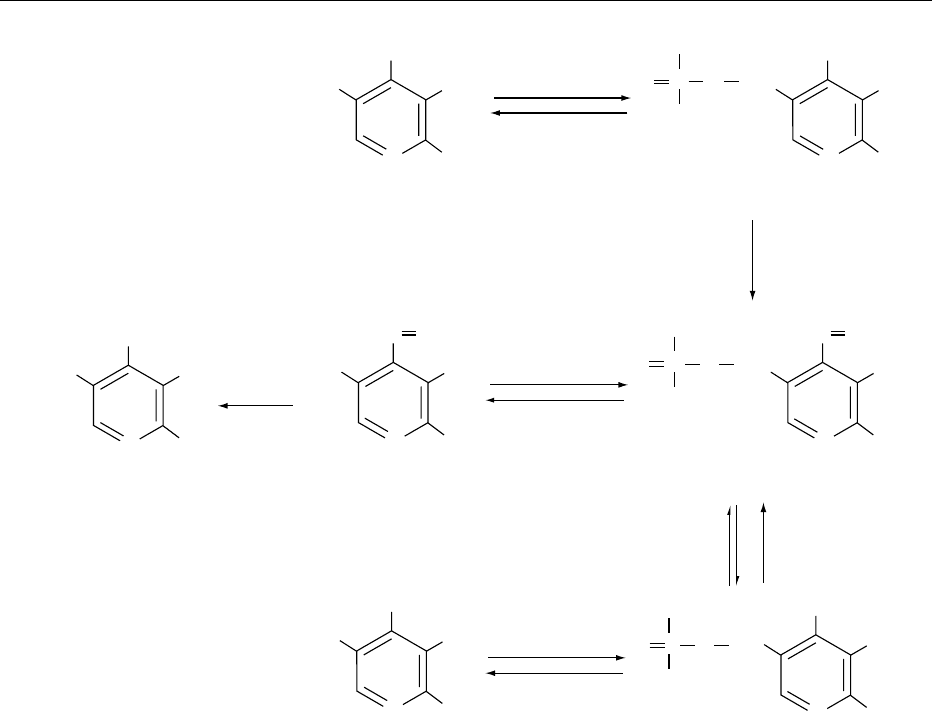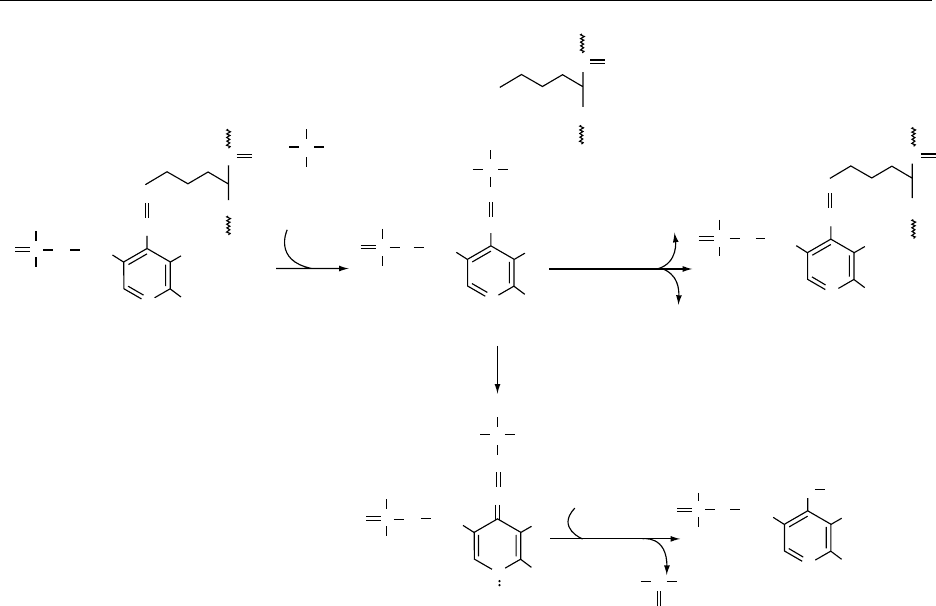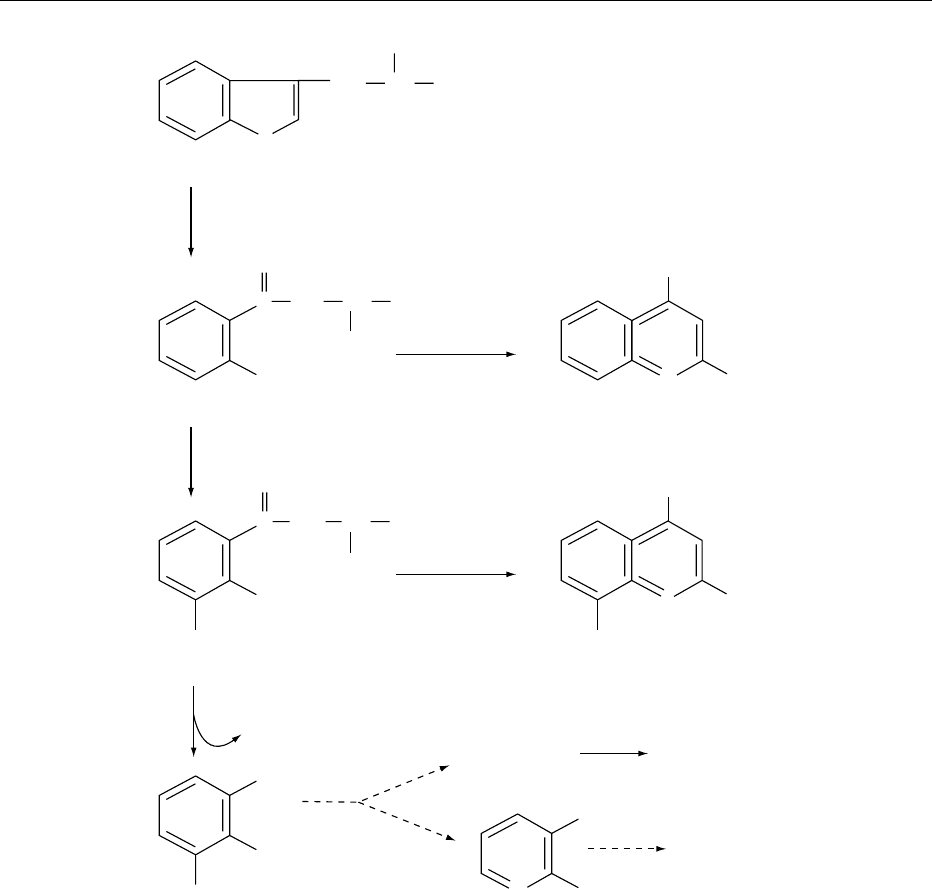Caballero B. (ed.) Encyclopaedia of Food Science, Food Technology and Nutrition. Ten-Volume Set
Подождите немного. Документ загружается.


Immunologic Assays
0032 Antibodies specific for (phospho)pyridoxyl groups
have been utilized in immunoassays for certain B
6
vitamers. However, there is a marked variation in
the affinity of the antibodies for the B
6
vitamers, so
these methods are not widely used.
Gas Chromatographic Assays
0033 Unless B
6
vitamers are nonphosphorylated and
their polar functional groups derivatized, these
compounds are not well suited for GC analysis.
Nonvolatile components and water are not easily
removed from sample extracts. Methods involving
the formation of acetyl, isopropylidene, trimethylsi-
lyl, trifluoroacetyl, and heptafluorobutyryl deriva-
tives of the nonphosphorylated B
6
vitamers have
been developed, but other chromatographic methods
are preferred.
HPLC Assays
0034 The physiochemical properties of the B
6
vitamers
facilitate their assay by HPLC assay. HPLC has the
potential for high resolution and high sensitivity with
regard to the B
6
vitamers found in biological mater-
ials, without the necessity of complex extraction and
derivatization techniques. If desired, the phosphate
esters of the phosphorylated B
6
vitamers can be
hydrolyzed using phosphatase yielding nonphos-
phorylated vitamers. Otherwise, the phosphorylated
vitamers can be preserved during extraction and
quantitated as such. All six B
6
vitamers and 4-PA
can be quantitated at nanogram levels using HPLC
techniques. Alternatively, all forms of the vitamer can
also be converted to PN, followed by HPLC quantita-
tion of total vitamin B
6
as PN techniques. This
method is rapidly becoming the preferred way of
determining total vitamin B
6
. Ion-exchange (anion
or cation) and reversed-phase (with or without
paired-ion) HPLC methods for assay of B
6
vitamers
have been published. Most of the methods utilize
fluorescence detectors, although some methods,
particularly the earlier methods, do utilize ultraviolet
(UV) detectors; the fluorescence detector is far
more sensitive and specific. The use of an internal
standard, most frequently 4-deoxypyridoxine, in-
creases the accuracy and precision of HPLC analysis
of B
6
vitamers, providing that it is not naturally
present in the samples. External standards (spiking)
are also utilized in proving identities of the peaks.
The identities of the peaks should be confirmed by
other means such as mass spectrometry and fluores-
cence spectra.
0035 Ion-exchange chromatography is accomplished
using packing material that possesses charge-bearing
functional groups. Many of the HPLC separations
reported in the 1970s were cation- or anion-exchange
methodologies, which generally involved determin-
ations of nonphosphorylated B
6
vitamers in acid
hydrolysates. An HPLC method has been developed
for the separation of all of the B
6
vitamers using
Aminex A-25 anion-exchange resin, isocratic elution,
and a pH 10 glycine buffer. This anionic method was
successfully applied to the determination of vitamin
B
6
components in milk, animal tissues, meats, and
fortified cereals. Unfortunately, the manufacturer
altered the composition of the resin in such a manner
that the method no longer provided satisfactory
separation of the vitamers. Also, a cation-exchange
HPLC method, fluorometric detection, has been
developed, which successfully quantitated all B
6
vitamers in plasma and other animal tissues.
0036Reversed-phase chromatography is the term given
to chromatographic conditions in which a nonpolar
stationary phase is used in conjunction with a polar
mobile phase. Gregory and Kirk were the first
to separate nonphosphorylated B
6
vitamers using
reversed-phase HPLC methods, with fluorescence de-
tection, which successfully measured PN in fortified
cereals.
0037Paired-ion (also called ion-pair) chromatography
was developed to deal with separating compounds
that are either very polar, multiply ionized, or strongly
basic. Several paired-ion, reversed-phase HPLC
methods, both gradient and isocratic, have been de-
veloped for determining vitamin B
6
components in
biological materials and foods. These methods have
also been utilized successfully in quantitating the six
B
6
vitamers and 4-PA in plasma. This type of
methodology may also be utilized in quantitating
glycosylated and other forms of the vitamin.
0038Several researchers have reported comparable
results when specific foods were analyzed for total
vitamin B
6
vitamer content using microbiological
(S. uvarum) and HPLC techniques. Most researchers
in the vitamin B
6
area believe that HPLC is the pre-
ferred method for determining the vitamin B
6
content
of food because individual vitamers can be deter-
mined. However, as indicated earlier, vitamin B
6
con-
tent data for food composition tables are obtained
primarily using microbiological (S. uvarum) methods.
As discussed earlier, the potencies of the B
6
vitamers
in the human body appear to be rather similar, so one
questions the importance of routinely determining
each of the six B
6
vitamers in foods. However it
does have academic interest and is of clinical signifi-
cance where drugs or diseases/conditions influence
the metabolism of the B
6
vitamers. Information as to
the form of the vitamin in food may be of importance
therapeutically.
6018 VITAMIN B
6
/Properties and Determination

Summary
0039 The quantitation of vitamin B
6
components in bio-
logical materials is difficult. The vitamin must be
extracted, generally using acidic media, from plant
and animal products before being analyzed by one
of the many chemical, biochemical or biological
methods. The official AOAC method for determin-
ation of the vitamin B
6
content of foods involves the
use of the microorganism Saccharomyces uvarum.
Although researchers have developed HPLC methods
that quantitate all six forms of the vitamin, these
methods are rarely utilized in determining the vitamin
B
6
content of food. Little difference appears to exist
in bioavailability of the different B
6
vitamers in
humans so total vitamin B
6
composition is deter-
mined by conversion to pyridoxine. Researchers are
continuing to seek improved methodologies for the
analysis of vitamin B
6
involving use of the latest
technology such as mass spectrometry. Additional
research is also needed to determine the importance
of specific forms of the vitamin in humans.
Seealso: Bioavailability of Nutrients; Chromatography:
High-performanceLiquidChromatography;Gas
Chromatography; Food Fortification
Further Reading
Ang CY (1979) Stability of three forms of vitamin B
6
to
laboratory light conditions. Journal of the Association of
Official Analytical Chemists 62: 1170–1173.
Association of Official Analytical Chemists (2000) Official
Methods of Analysis, 19th edn. Arlington, VA: AOAC.
Batenhorst JH, Sun J, Giraud DW et al. (1995) Retention of
selected nutrients in pork roasts prepared using different
cookery methods. Journal of Muscle Foods 6: 359–368.
Brin M (1978) Vitamin B
6
: chemistry, absorption, metabol-
ism, catabolism, and toxicity. In: Human Vitamin B
6
Requirements, pp. 1–20. Washington, DC: National
Academy of Sciences.
Chrisley BMc, Thye FW, McNair HM and Driskell JA
(1988) Plasma B-6 vitamer and 4-pyridoxic acid concen-
trations of men fed controlled diets. Journal of Chroma-
tography 428: 35–42.
DeRitter E (1976) Stability characteristics of vitamins in
processed foods. Food Technology 30: 48–54.
Driskell JA (1994) Vitamin B-6 requirements of humans.
Nutrition Research 14: 293–324.
Driskell JA (1995) Sensory and nutritive qualities of food
prepared by microwaving as compared to other cooking
methods. Microwave World 16(2): 6–9.
Eitenmiller RR and Landen WO, Jr (1999) Vitamin Analy-
sis for the Health and Food Sciences, Chapter 10. Boca
Raton, FL: CRC Press.
Gregory JF (1980) Effects of e-pyridoxyllysine bound to
dietary protein on the vitamin B-6 status of rats. Journal
of Nutrition 110: 995–1005.
Gregory JF (1988) Methods for determination of vitamin B
6
in foods and other biological materials: a critical
review. Journal of Food Composition and Analysis 1:
105–123.
Gregory JF (1990) The bioavailability of vitamin B
6
: recent
findings. Annals of the New York Academy of Sciences,
pp. 86–95. New York: New York Academy of Sciences.
Gregory JF (1997) Bioavailability of vitamin B-6. European
Journal of Clinical Nutrition 51: S43–S48.
Harris SA (1968) Pyridoxine. Encyclopedia of Chemical
Technology 16: 806–824.
International Union of Pure and Applied Chemistry – Inter-
national Union of Biochemistry, Commission on Bio-
chemical Nomenclature (1973) Nomenclature for
vitamin B
6
and related compounds: recommendations
1973. European Journal of Biochemistry 40: 325–327.
Johnson JA and Driskell J (1987) Vitamin retention and
sensory evaluation of selected foods prepared by boiling,
boiling-in-bag, and steaming methods. Home Econom-
ics Research Journal 16: 136–142.
Leklem JE and Reynolds RD (eds) (1981) Methods in Vita-
min B-6 Nutrition: Analysis and Status Assessment.
New York: Plenum Press.
Leklem JE (1991) Vitamin B
6
. In: Machlin LJ (ed.) Hand-
book of Vitamins, 2nd edn., Chapter 9. New York:
Marcel Dekker.
McCance RA, Widdowson EM and Holland B (1993) The
Composition of Foods, 5th edn. London: Springer Verlag.
McCormick DB and Chen H (1999) Update on interconver-
sions of vitamin B-6 with its coenzyme. Journal of
Nutrition 129: 325–327.
Orr ML (1969) Pantothenic Acid, Vitamin B
6
and Vitamin
B
12
in Foods. US Department of Agriculture, Home
Economics Research Report No. 36. Washington, DC:
US Government Printing Office.
Reiter LA and Driskell JA (1985) Vitamin B-6 content of
selected foods served in dining halls. Journal of The
American Dietetic Association 85: 1625–1627.
Sauberlich HE (1999) Laboratory Tests for the Assessment
of Nutritional Status. Boca Raton, FL: CRC Press.
Storvick CA, Benson EM, Edwards MA and Woodring MJ
(1964) Chemical and microbiological determination
of vitamin B
6
. Methods of Biochemical Analysis XII:
183–276.
Ubbink JB (1992) Vitamin B
6
. In: DeLeenheer AP, Lambert
WE and Nelis HJ (eds) Modern Chromatographic
Analysis of the Vitamins, 2nd edn., Chapter 10. New
York: Marcel Dekker.
US Department of Agriculture, Agricultural Research Ser-
vice (1999) USDA Nutrient Database for Standard Ref-
erence, Release 13. Nutrient Data Laboratory Home
Page, http://www.nal.usda.gov/fnic/foodcomp.
Yang J, Sulaeman A, Setiawan B et al. (1994) Sensory
qualities and nutrient retention of beef strips prepared
by different household cooking techniques. Journal of
The American Dietetic Association 94: 199–201.
Yang J, Sulaeman A, Setiawan B et al. (1994) Sensory and
nutritive qualities of pork strips prepared by three house-
hold cooking techniques. Journal of Food Quality 17:
33–40.
VITAMIN B
6
/Properties and Determination 6019

Yuan X, Marchello MJ and Driskell JA (1999) Selected
vitamin contents and retentions in bison patties as re-
lated to cooking method. Journal of Food Science 64:
462–464.
Physiology
D A Bender, University College London, London, UK
Copyright 2003, Elsevier Science Ltd. All Rights Reserved.
Introduction
0001 Vitamin B
6
has a central role in amino acid metabol-
ism, as the coenzyme for a variety of reactions, in-
cluding transamination and decarboxylation. It is also
the coenzyme of glycogen phosphorylase, and acts to
modulate the activity of steroid and other hormones
(including retinoids and vitamin D) which act by
regulation of gene expression.
Dietary Forms, Biological Availability, and
Metabolism
0002 The main form of vitamin B
6
in foods is pyridoxal
phosphate, bound to enzymes. There is also a small
amount of pyridoxamine phosphate. In plant foods a
significant amount of the vitamin is present as pyrid-
oxine.
0003 A number of plants contain relatively large amounts
of pyridoxine glycosides, which are not biologically
available, since they are not substrates for mamma-
lian glycosidases. They are absorbed (passively) from
the intestinal lumen and are excreted more or less
quantitatively in the urine. Between 5% and 50% of
the total vitamin B
6
in some foods may be present as
pyridoxine glycosides.
0004 A proportion of the vitamin B
6
in foods may be
biologically unavailable, especially after heating, as a
result of the formation of (phospho)pyridoxyllysine
by reduction of the aldimine (Schiff base), by which
pyridoxal phosphate is bound to the e-amino groups
of lysine residues in proteins. While some of this
pyridoxyllysine may be useable, since it is a substrate
for pyridoxine phosphate oxidase, it is also a vitamin
B
6
antimetabolite, and even at relatively low concen-
trations can accelerate the development of deficiency
in experimental animals maintained on deficient
diets. In the 1950s there was an outbreak of vitamin
B
6
deficiency among infants fed on formula that had
been overheated in manufacture, resulting in the for-
mation of relatively large amounts of pyridoxyllysine.
Digestion and Absorption
0005Pyridoxal phosphate bound as a Schiff base to
lysine in dietary proteins is released on digestion
of the protein. The phosphorylated vitamers are
dephosphorylated by membrane-bound alkaline
phosphatase in the intestinal mucosa; pyridoxal, pyr-
idoxamine, and pyridoxine are all absorbed rapidly
by passive diffusion. Intestinal mucosal cells have
pyridoxine kinase, and pyridoxine phosphate oxidase
so that there is net accumulation by metabolic trap-
ping. Much of the ingested pyridoxine is released into
the portal circulation as pyridoxal, after dephos-
phorylation at the serosal surface.
Metabolism and Transport
0006Most of the absorbed vitamin is taken up by the liver,
although other tissues can also take up the unpho-
sphorylated vitamers from the circulation. Uptake is
by carrier-mediated diffusion, followed by metabolic
trapping as phosphate esters. Pyridoxine and pyri-
doxamine phosphates are oxidized to pyridoxal phos-
phate. All tissues have pyridoxine kinase activity, but
pyridoxine phosphate oxidase is only found in liver,
kidney, and brain (Figure 1).
0007Pyridoxine phosphate oxidase is a flavoprotein,
and its activity falls markedly in riboflavin deficiency.
Despite this central role of riboflavin in vitamin B
6
metabolism, blood and tissue concentrations of
pyridoxal phosphate are not affected by riboflavin
deficiency, and riboflavin nutrition appears to have
no effect on vitamin B
6
nutritional status.
0008Pyridoxine phosphate oxidase is inhibited by its
product, pyridoxal phosphate. This is not simple
product inhibition, but involves binding at a specific
inhibitor site on the enzyme. The normal intracellular
concentration of free pyridoxal phosphate gives
significant inhibition, which indicates that this is a
physiologically important mechanism in the control
of tissue pyridoxal phosphate.
0009Pyridoxine is phosphorylated rapidly in liver
and other tissues. Pyridoxal phosphate does not
cross cell membranes, and uptake and efflux of the
vitamin in most tissues are as pyridoxal. Pyridoxal
phosphate is exported from the liver bound to
albumin. Much of the free pyridoxal phosphate in
the liver is hydrolyzed to pyridoxal, which is also
exported, and circulates bound both to albumin and
to hemoglobin in erythrocytes. Free pyridoxal
remaining in the liver is rapidly oxidized to 4-pyri-
doxic acid, which is the main excretory product of the
vitamin.
0010Extrahepatic tissues take up pyridoxal from the
plasma. Pyridoxal phosphate is hydrolyzed to
pyridoxal, which can cross cell membranes, by
6020 VITAMIN B
6
/Physiology

extracellular alkaline phosphatase, then trapped
intracellularly by phosphorylation.
0011 Tissue concentrations of pyridoxal phosphate are
controlled by the balance between phosphorylation
and dephosphorylation. The activity of phosphatases
acting on pyridoxal phosphate is greater than that of
the kinase in most tissues. This means that pyridoxal
phosphate that is not bound to enzymes will be
dephosphorylated and hence leave the cell by diffu-
sion. Thus there is little accumulation of pyridoxal
phosphate in tissues, other than that which is
bound to enzymes and other proteins (e.g., hormone
receptors).
0012 Free pyridoxal either leaves the cell or is oxidized
to 4-pyridoxic acid by aldehyde dehydrogenase,
which is present in all tissues, and also by hepatic
and renal aldehyde oxidase. 4-Pyridoxic acid is the
main excretory product of vitamin B
6
, and its excre-
tion reflects recent intake more than the state of
underlying tissue reserves of the vitamin. Small
amounts of pyridoxal and pyridoxamine are also
excreted in the urine, although much of the active
vitamin B
6
which is filtered at the glomerulus is
resorbed in the kidney tubules.
Storage and Body Reserves
0013There is no specific storage of vitamin B
6
in the body;
as discussed above, pyridoxal phosphate that is
not bound to enzymes is rapidly dephosphorylated,
oxidized to 4-pyridoxic acid, and excreted.
0014The total body pool of vitamin B
6
is of the order of
60 mmol (250 mg); 15 mmol (3.7 mg) per kg body
weight. About 80% of this is in muscle, associated
with glycogen phosphorylase. This does not seem to
function as a true reserve of the vitamin and is not
released from muscle in times of deficiency.
0015Muscle pyridoxal phosphate is released into the
circulation (as pyridoxal) in starvation, as muscle
glycogen reserves are exhausted, and there is less
requirement for glycogen phosphorylase activity.
Under these conditions it is available for redistribu-
tion to other tissues, especially liver and kidney, to
N
CH
2
OH
HOCH
2
OH
CH
3
N
CH
2
OH
CH
2
OH
CH
3
N
HC
CH
2
OH
CH
3
N
HC O
HOCH
2
OH
CH
3
N
CH
2
NH
2
HOCH
2
OH
CH
3
N
CH
2
NH
2
CH
2
OH
CH
3
N
COOH
HOCH
2
OH
CH
3
Kinase
Phosphatase
Kinase
Phosphatase
Kinase
Phosphatase
O
OH
OH
OO
OH
OH
OO
P
P
OH
OH
OOP
Pyridoxine
Pyridoxal
Pyridoxine phosphate
Oxidase
Oxidase
4-Pyridoxic acid Pyridoxal phosphate
Transaminases
Oxidase
Pyridoxamine Pyridoxamine phosphate
fig0001 Figure 1 Metabolism of vitamin B
6
.
VITAMIN B
6
/Physiology 6021

meet the increased requirement of transamination of
amino acids for gluconeogenesis.
Metabolic Functions of Vitamin B
6
0016 The metabolically active vitamer is pyridoxal phos-
phate, which is involved in many reactions of amino
acid metabolism, where the carbonyl group is the
reactive moiety, in glycogen phosphorylase, where it
is the phosphate group that is important in catalysis,
and in the release of hormone receptors from tight
nuclear binding, where again it is the carbonyl group
that is important.
The Role of Pyridoxal Phosphate in Amino Acid
Metabolism
0017 The various reactions of pyridoxal phosphate in amino
acid metabolism (Figure 2) all depend on the same
chemical principle – the ability to stabilize amino acid
carbanions, and hence to weaken bonds about the
a-carbon of the substrate. This is achieved by reaction
of the a-amino group with the carbonyl group of the
coenzyme to form a Schiff base (aldimine).
0018 Pyridoxal phosphate is bound to enzymes, in the
absence of the substrate, by the formation of an
internal Schiff base to the e-amino group of a lysine
residue at the active site. Thus the first reaction be-
tween the substrate and the coenzyme is transfer of
the aldimine linkage from this e-amino group to the
a-amino group of the substrate.
0019The ring nitrogen of pyridoxal phosphate exerts a
strong electron-withdrawing effect on the aldimine,
and this leads to weakening of all three bonds about
the a-carbon of the substrate. In nonenzymic model
systems, all the possible pyridoxal-catalyzed reac-
tions are observed: a-decarboxylation, aminotransfer,
racemization, and relevant side-chain elimination and
replacement reactions. By contrast, enzymes show
specificity for the reaction pathway followed; which
bond is cleaved will depend on the orientation of
the Schiff base relative to reactive groups of the cata-
lytic site. However, a number of decarboxylases and
enzymes that catalyze side-chain elimination reac-
tions of amino acids undergo gradual inactivation as
a result of catalyzing the half-reaction of transamina-
tion, leaving (catalytically inactive) pyridoxamine
phosphate at the catalytic site.
0020a-Decarboxylation If the electron-withdrawing
effect of the ring nitrogen is primarily centered on
N
HC
CH
2
OH
CH
3
OH
OH
OOP
N
HC
CH
2
OH
CH
3
OH
OH
O
OP
N
Lysine
Lysine
NH
C
C
O
C
O
R
H
COOH
NH
2
CR
H
COOH
N
CR COOH
O
N
HC
CH
2
OH
CH
3
OH
OH
OOP
N
Amino acid
substrate
H
2
N
NH
Lysine
C
O
NH
Decarboxylation
CO
2
Substrate aldimine
N
HC
CH
2
OH
CH
3
OH
OH
O
O
P
C
R
H
COOH
N
Substrate ketimine
N
H
2
C
CH
2
OH
CH
3
OH
OH
O
OP
Pyridoxamine phosphate
Tautomerization
Pyridoxal phosphate internal aldimine
(Schiff base)
R−CH
2
−NH
2
Product amine
Transamination
(amino transfer)
H
2
O
Product oxo-acid
(keto-acid)
NH
2
fig0002 Figure 2 Roles of vitamin B
6
in amino acid metabolism.
6022 VITAMIN B
6
/Physiology

the a-carbon-carboxyl bond, the result is decarboxy-
lation of the amino acid with the release of carbon
dioxide. The resultant carbanion is then protonated,
and the primary amine corresponding to the amino
acid is displaced by the lysine residue at the active site,
with reformation of the internal Schiff base.
0021 A number of the products of the decarboxylation of
amino acids are important as neurotransmitters and
hormones: 5-hydroxytryptamine, the catecholamines
dopamine, norepinephrine (noradrenaline), and epi-
nephrine (adrenaline), histamine and g-aminobuty-
rate (GABA), and as the diamines and polyamines
involved in the regulation of DNA metabolism. The
decarboxylation of phosphatidylserine to phospha-
tidylethanolamine is important in phospholipid
metabolism.
0022 Racemization of Amino Acids Deprotonation of the
a-carbon of the amino acid leads to tautomerization
of the Schiff base to yield a quinonoid ketimine. The
simplest reaction that the ketimine can undergo is
reprotonation at the now symmetrical a-carbon. Dis-
placement of the substrate by the reactive lysine resi-
due results in the racemic mixture of d- and l-amino
acid.
0023 Amino acid racemases are important in bacterial
metabolism, since several d-amino acids are
required for the synthesis of cell wall mucopolysac-
charides. There is no evidence that there are any
mammalian amino acid racemases; such utilization
of d-amino acids as occurs is probably due to the
action of renal d-amino acids oxidase to form
the symmetrical 2-oxo-acid which is then a substrate
for transamination.
0024Transamination Hydrolysis of the a-carbon-amino
bond of the ketimine formed by deprotonation of the
a-carbon of the amino acid results in the release of
the 2-oxo-acid corresponding to the amino acid sub-
strate, and leaves pyridoxamine phosphate at the
catalytic site of the enzyme. In this case there is no
reformation of the internal Schiff base to the reactive
lysine residue. This is the half-reaction of transamina-
tion. The process is completed by reaction of pyridox-
amine phosphate with a second oxo-acid substrate,
forming an intermediate ketimine, followed by the
reverse of the reaction sequence shown in Figure 2,
releasing the amino acid corresponding to this second
substrate after displacement from the aldimine by the
reactive lysine residue to reform the internal Schiff
base.
0025Transamination (Figure 3) is of central importance
in amino acid metabolism, providing pathways for
the catabolism of all of the amino acids except lysine,
which does not undergo transamination. Many of
these reactions are linked to the amination of 2-oxo-
glutarate to glutamate or glyoxylate to glycine, which
are substrates for oxidative deamination, reforming
the oxo-acids. Transamination reactions also provide
a pathway for the synthesis of those amino acids for
which there is an alternative source of the oxo-acid
(the nonessential amino acids). Indeed, the nonessen-
tial amino acids can be defined as those whose oxo-
acids can be formed other than from the amino acid
itself.
0026Side-chain elimination and replacement reac-
tions The third bond in the Schiff base aldimine
that can be labilized by the electron-withdrawing
H
R
1
C COOH
NH
2
OO
O
OH
OH
OH
P
CH
2
H
C
CH
3
N
Pyridoxal phosphate
Substrate amino acid
Amino donor
H
R
2
C COOH
NH
2
Product amino acid
R
1
C COOH
O
R
2
C COOH
O
OO
OH
OH
OH
P
CH
2
CH
2
CH
3
N
Pyridoxamine phosphate
Product oxo-acid (keto-acid)
Substrate oxo-acid (keto-acid)
Amino acceptor
NH
2
fig0003 Figure 3 The role of vitamin B
6
in transamination reactions.
VITAMIN B
6
/Physiology 6023

effect of the ring nitrogen of pyridoxal phosphate is
that between the a-carbon and the side-chain of the
amino acids, resulting in a variety of a–b elimination
and b–g replacement reactions.
The Role of Pyridoxal Phosphate in Glycogen
Phosphorylase
0027 Glycogen phosphorylase catalyzes the sequential
phosphorolysis of glycogen to release glucose 1-phos-
phate; it is thus the key enzyme in the utilization of
muscle and liver reserves of glycogen.
0028 Unlike other pyridoxal phosphate-dependent
enzymes, in which the carbonyl group is essential
for catalysis, the internal Schiff base between pyri-
doxal phosphate and lysine in glycogen phosphory-
lase is not broken during the reaction. The catalytic
region of the coenzyme is the 5
0
-phosphate group.
The initial stage in the phosphorolysis of glycogen
is protonation of the glycosidic oxygen of the poly-
saccharide by inorganic phosphate. The resultant
oxycarbonium ion is stabilized by the inorganic phos-
phate. The role of pyridoxal phosphate is as a proton
shuttle or buffer to stabilize the oxycarbonium-
phosphate ion pair, permitting covalent binding of
the phosphate to the oxycarbonium ion, to form
glucose 1-phosphate.
The Role of Pyridoxal Phosphate in Steroid
Hormone Action
0029 Pyridoxal phosphate has a role in modulating the
action of those hormones which act by binding to a
nuclear receptor protein, inducing transcription of
DNA, and hence regulating gene expression, leading
to new protein synthesis. Such hormones include an-
drogens, estrogens, progesterone, glucocorticoids,
calcitriol (the active metabolite of vitamin D), reti-
noic acid and other retinoids, and thyroid hormone.
Target-tissue specificity of hormone action is insured
by the presence of characteristic receptor proteins
with a zinc finger motif, which are responsible for
both nuclear uptake of the hormone and the inter-
action with DNA and nucleoproteins to initiate gene
expression.
0030 Pyridoxal phosphate reacts with a lysine residue in
the receptor protein, and displaces the hormone–
receptor complex from tight nuclear binding.
In vitro, reaction with pyridoxal phosphate also in-
hibits the binding of receptor protein to isolated DNA
and chromatin. The effect is specific for the phosphor-
ylated vitamer, suggesting that there may be a specific
pyridoxal-phosphate binding site on the receptor pro-
teins, and it occurs at low concentrations of pyridoxal
phosphate, of the same order of magnitude as occur in
tissues under normal conditions.
0031This suggests that pyridoxal phosphate acts as a
cofactor in the release of hormone–receptor com-
plexes from tight nuclear binding, resulting in release
of the receptor from the nucleus, termination of
hormone action, and recycling receptor protein for
further uptake of hormone.
0032In experimental animals, vitamin B
6
deficiency
results in increased and prolonged nuclear uptake
and retention of steroid hormones in target tissues,
and there is enhanced sensitivity to hormone action.
Deficient animals show greater induction of uterine
peroxidase, and considerably greater suppression of
the hypothalamic secretion of luteinizing hormone,
by estrogens than do vitamin B
6
-supplemented con-
trols. In vitamin B
6
-deficient male animals there is an
increased mitotic response of the prostate to low
doses of testosterone. Deficient male animals have a
higher activity of ornithine decarboxylase (an andro-
gen-induced enzyme) in the liver, and deficient
females have higher renal ornithine transaminase
(an estrogen-induced enzyme). The induction of
hepatic tyrosine transaminase and tryptophan dioxy-
genase by glucocorticoids is also enhanced in vitamin
B
6
-deficient animals.
0033In a variety of cells in culture that have been trans-
fected with a glucocorticoid, estrogen, or progester-
one response element linked to a reporter gene, acute
vitamin B
6
depletion (by incubation with 4-deoxypyr-
idoxine) leads to a twofold increase in expression of
the reporter gene in response to hormone action.
Conversely, incubation of these cells with high con-
centrations of pyridoxal, leading to a high intracellu-
lar concentration of pyridoxal phosphate, results in
a halving of the expression of the reporter gene in
response to hormone stimulation.
Criteria of Adequacy and Assessment of
Nutritional Status
Plasma Concentrations of the Vitamin
0034The fasting plasma concentration of either total vita-
min B
6
or, more specifically, pyridoxal phosphate, is
widely used as an index of vitamin B
6
nutritional
status. The generally accepted criteria of adequacy
are shown in Table 1.
0035Conditions that involve increased plasma activity
of alkaline phosphatase may result in reduced plasma
pyridoxal phosphate, without affecting tissue concen-
trations of pyridoxal phosphate or vitamin B
6
nutri-
tional status, as assessed by other criteria. There is a
compensatory increase in the circulating concentra-
tion of pyridoxal, which is the main form for tissue
uptake of vitamin B
6
. Despite the fall in plasma
pyridoxal phosphate in pregnancy, which has been
6024 VITAMIN B
6
/Physiology

widely interpreted as indicating vitamin B
6
depletion,
the plasma concentration of (pyridoxal phosphate
plus pyridoxal) is unchanged. This suggests that de-
termination of plasma pyridoxal phosphate alone
may not be a reliable index of vitamin B
6
nutritional
status.
Urinary Excretion of 4-Pyridoxic Acid
0036 About half of the normal dietary intake of vitamin B
6
is excreted as 4-pyridoxic acid. Urinary excretion of
4-pyridoxic acid will largely reflect recent intake of
the vitamin rather than underlying nutritional status;
the criteria for assessment of 4-pyridoxic acid
excretion are shown in Table 1.
Coenzyme Saturation of Transaminases
0037 Various pyridoxal phosphate-dependent enzymes
compete with each other for the available pool of
coenzyme. Thus the extent to which an enzyme is
saturated with its coenzyme provides a means of as-
sessing the adequacy of the body pool of coenzyme.
This can be determined by measuring the activity of
the enzyme before and after the activation of any
apoenzyme present in the sample by incubation with
pyridoxal phosphate added in vitro. Erythrocyte
aspartate and alanine transaminases are both com-
monly used; the results are expressed as either the
percentage stimulation of activity by added pyridoxal
phosphate, or the activation coefficient – the ratio of
activity with added coenzyme to that without added
coenzyme.
0038 It seems to be normal for a proportion of pyridoxal
phosphate-dependent enzymes to be present as in-
active apoenzyme, without coenzyme. This may be a
mechanism for metabolic regulation. It is possible
that increasing the intake of vitamin B
6
,soasto
insure complete saturation of pyridoxal phosphate-
dependent enzymes, may not be desirable.
Metabolic Loading Tests
0039A direct test of the adequacy of an individual’s intake
to meet his or her idiosyncratic metabolic require-
ment is the ability to metabolize a test dose of a
substrate whose metabolism is dependent on the vita-
min. For vitamin B
6
, two metabolic loading tests can
be used, although neither can be considered to be
reliable for population studies of vitamin B
6
status.
0040The Tryptophan Load Test The oxidative pathway
of tryptophan metabolism is shown in Figure 4.
Kynureninase is a pyridoxal phosphate-dependent
enzyme, and in vitamin B
6
deficiency its activity is
lower than that of tryptophan dioxygenase. This
means that there is a considerable accumulation of
both hydroxykynurenine and kynurenine, sufficient
to permit greater than usual metabolic flux through
kynurenine transaminase, resulting in increased for-
mation of kynurenic and xanthurenic acids. Although
kynurenine transaminase is also pyridoxal phos-
phate-dependent, it is relatively unaffected in vitamin
B
6
deficiency. Kynureninase is exquisitely sensitive to
vitamin B
6
deficiency because it undergoes a slow
inactivation as a result of catalyzing the half-reaction
of transamination in addition to its normal reaction.
The resultant enzyme with pyridoxamine phosphate
at the catalytic site is catalytically inactive, and can
only be reactivated if there is an adequate concen-
tration of pyridoxal phosphate to displace the
pyridoxamine phosphate.
0041Xanthurenic and kynurenic acids are easy to
measure in urine, so that the ability to metabolize a
test dose of 2 or 5 g of tryptophan has been widely
adopted as a convenient and sensitive index of vita-
min B
6
nutritional status. However, induction of tryp-
tophan dioxygenase by glucocorticoid hormones will
result in a greater rate of formation of kynurenine and
hydroxykynurenine than the capacity of kynureni-
nase, and will thus lead to increased formation of
kynurenic and xanthurenic acids – an effect similar
to that seen in vitamin B
6
deficiency. Such results may
be erroneously interpreted as indicating vitamin B
6
deficiency in a variety of subjects whose problem is
increased glucocorticoid secretion as a result of stress
or illness, not vitamin B
6
deficiency.
0042Inhibition of kynureninase, e.g., by estrogen me-
tabolites, also results in accumulation of kynurenine
and hydroxykynurenine, and hence increased forma-
tion of kynurenic and xanthurenic acids, again giving
results which falsely suggest vitamin B
6
deficiency.
tbl0001 Table 1 Indices of vitamin B
6
nutritional status
Adequate status
Plasma total vitamin B
6
> 40 nmol (10 mg) l
1
Plasma pyridoxal phosphate >30 nmol (7.5 mg) l
1
Erythrocyte alanine aminotransferase
activation coefficient
<1.25
Erythrocyte asparate aminotransferase
activation coefficient
<1.80
Erythrocyte asparate aminotransferase >0.13 units
(8.4 mkat) l
1
Urine 4-pyridoxic acid >3.0 mmol 24 h
1
>1.3 mmol mol
1
creatinine
Urine total vitamin B
6
>0.5 mmol 24 h
1
>0.2 mmol mol
1
creatinine
Urine xanthurenic acid after 2 g
tryptophan load
<65 mmol 24 h
1
increase
Urine cystathionine after 3 g methionine
load
<350 mmol 24 h
1
increase
VITAMIN B
6
/Physiology 6025

This has been widely, but incorrectly, interpreted as
estrogen-induced vitamin B
6
deficiency – it is in fact
simple competitive inhibition by estrogen metabolites
of the enzyme that is the basis of the tryptophan load
test.
0043 There is normally a considerable excess of either
apokynureninase or kynureninase that has undergone
transamination, and has pyridoxamine phosphate at
the catalytic site, in the liver. This can be activated by
(relatively high concentrations of) pyridoxal phos-
phate. The abnormalities of tryptophan metabolism
associated with increased activity of tryptophan diox-
ygenase, or inhibition of kynureninase by estrogen
metabolites, are thus corrected by the administration
of high doses of vitamin B
6
, although they are not in
fact due to deficiency.
0044This means that, while the tryptophan load test
may be an appropriate index of status in controlled
depletion/repletion studies to determine vitamin B
6
requirements, it is not an appropriate index of status
in population studies.
0045The methionine loading test The metabolism of me-
thionine, shown in Figure 5, includes two pyridoxal
phosphate-dependent steps, catalyzed by cystathio-
nine synthetase and cystathionase. In vitamin B
6
deficiency there is an increase in the plasma concen-
tration of homocysteine, and increased urinary
CH
2
CH
2
CH
CH
COOH
COOH
NH
2
NH
2
NH
2
N
Tryptophan
H
Tryptophan dioxygenase and
formylkynurenine hydroxylase
C
O
Kynurenine
aminotransferase
N
OH
OH
COOH
CH
2
CH COOH
NH
2
NH
2
C
O
Kynurenine
aminotransferase
N
COOH
Kynurenine
Kynurenic acid
OH
OH
3-Hydroxykynurenine
OH
3-Hydroxyanthranilic acid
Kynureninase
(vitamin B
6
-dependent)
Alanine
Xanthurenic acid
COOH
NH
2
COOH
COOH
N
Acetyl CoA
CO
2
Quinolinic acid
Nicotinamide
Kynurenine hydroxylase
fig0004 Figure 4 The oxidative pathway of tryptophan metabolism – the basis of the tryptophan load test for vitamin B
6
status.
6026 VITAMIN B
6
/Physiology

excretion of cystathionine and homocysteine, both
after a loading dose of methionine and under basal
conditions. The ability to metabolize a test dose of
methionine therefore provides an index of vitamin B
6
nutritional status. Because measurement of homocys-
teine and cystathionine is technically less easy than
measurement of xanthurenic and kynurenic acids, the
methionine load test has been less widely used than
the tryptophan load test.
0046 Some 10–25% of the population have a genetic
predisposition to hyperhomocysteinemia, which is
a risk factor for atherosclerosis and coronary heart
disease, as a result of polymorphism in the gene for
methylenetetrahydrofolate reductase. As discussed
below, there is no evidence that supplements of vita-
min B
6
reduce fasting plasma homocysteine in these
subjects and, like the tryptophan load test, the
methionine load test may be an appropriate index
of status in controlled depletion/repletion studies
to determine vitamin B
6
requirements, but not in
population studies.
Requirements and Recommendations
0047The total body pool of vitamin B
6
is of the order of
15 mmol (3.7 mg) per kg of body weight. Isotope
tracer studies suggest that there is a turnover of
about 0.13% per day, and hence a minimum require-
ment for replacement of 0.02 mmol (5 mg) per kg of
body weight – some 350 mg day
1
for a 70-kg adult.
0048Most studies of vitamin B
6
requirements have
followed the development of abnormalities of trypto-
phan (and sometimes also methionine) metabolism
during depletion, and normalization during repletion
with graded intakes of the vitamin. While the trypto-
phan and methionine loading tests are unreliable as
Methylated
product
Acceptor
S-adenosylmethionine S -adenosylhomocysteine
Methyltransferase
CH
3
CH
2
CH
2
Methionine adenosyltransferase
ATP
PP
i,
P
i
Adenosine
S
HC
NH
2
COOH
CH
2
CH
2
CH
2
CH
2
CH
2
CH
2
SH
SS
HC
NH
2
COOH
HC
NH
2
COOH
HC
NH
2
COOH
CH
2
CH
2
CH
2
S
SH
HC
NH
2
COOH
HC
NH
2
COOH
CH
2
HC
NH
2
COOH
Methionine
Tetrahydrofolate
Methyl
tetrahydrofolate
Methionine synthetase
(vitamin B
12
-dependent)
Homocysteine Homocystine
Nonenzymic
Cystathionine Cysteine
Serine
H
2
O
Cystathionase
(vitamin B
6
-dependent)
Cystathionine synthetase
(vitamin B
6
-dependent)
H
2
O
NH
4
+
+
α-Ketobutyrate
fig0005 Figure 5 The pathway of methionine metabolism – the basis of the methionine load test for vitamin B
6
status.
VITAMIN B
6
/Physiology 6027
